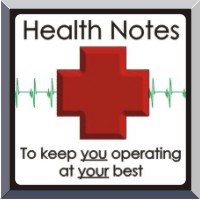 We were reading Well Being Journal when we ran across a couple articles on gall bladders. Realizing we didn’t know what a gall bladder did, we thought an article on it might be educational for everyone. Here’s some information on what a gall bladder is, how to perform a gall bladder flush, natural ways to support gall bladder function, and what foods to eat for a happy gall bladder.
We were reading Well Being Journal when we ran across a couple articles on gall bladders. Realizing we didn’t know what a gall bladder did, we thought an article on it might be educational for everyone. Here’s some information on what a gall bladder is, how to perform a gall bladder flush, natural ways to support gall bladder function, and what foods to eat for a happy gall bladder.
The gallbladder is a small pouch that sits just under the liver. The gallbladder stores bile produced by the liver. After meals, the gallbladder is empty and flat, like a deflated balloon. Before a meal, the gallbladder may be full of bile and about the size of a small pear.
In response to signals, the gallbladder squeezes stored bile into the small intestine through a series of tubes called ducts. Bile helps digest fats, but the gallbladder itself is not essential. Removing the gallbladder in an otherwise healthy individual typically causes no observable problems with health or digestion yet there may be a small risk of diarrhea and fat malabsorption.
Prevent Gallbladder Difficulties
by Dr. Jonathan Wright, The Well Being Journal, May/June 2012
James C. Breneman, M.D., discovered in the 1960’s how to prevent gallbladder attacks: Keep away from things you are allergic to! Jonathan V. Wright, M.D., notes that doctors, if you are hospitalized with a gallbladder attack, take away all foods and give you IV fluids. You aren’t allowed to eat anything until the pain goes away. Wright says of Breneman’s method of removing allergenic foods from the diet, “If it was used as a first line of defense, this technique would make 99.9% of all gallbladder surgeries…totally unnecessary.” Wright has used the technique (removing foods to which a person is allergic in the diet) for over thirty years and has never needed to refer anyone presenting a gallbladder problem for gallbladder surgery.
Wright notes, “Back in 1968 [Breneman] asked 69 individuals suffering from recurrent attacks of gallbladder pain to go onto an elimination diet to determine their food allergies. Six of these individuals had already had their gallbladders out but were still having attacks of gallbladder pain, a situation termed ‘post-cholecystectomy syndrome’… Breneman reported that all 69 people (100%!) were completely free of gallbladder attacks when they avoided their individual food (and other) allergies. And all 69 had their symptoms return when they ate the foods they were allergic to once more.”
To determine the food or medication allergies, ask for assistance from the American Academy of Environmental Medicine at 316-684-5500 or www.aaem.com.
Wright also advises, for those who have had their gallbladders removed, that there is a natural way to make sure that the bile formerly released by the gallbladder can be replaced by supplementation to help the body take in the nutrients from the much needed essential fats and fatty acids- as well as the fat-soluble vitamins that are so essential (A, D, E, and K). Get a bottle of “bile salts” or bile in tablet form. Wright suggests taking one to three tablets or capsules with every meal containing more than a bit of fat or oil. Too much will cause a bowel movement to be too dark and loose; too little salts and the movement will be very light in color.
Gallstones
Wright also suggests that “sleeping” or “silent” gallstones are those not associated with any gallbladder attack. When allergy avoidance prevents the attacks, it does so whether gallstones are present or not. If stones are present but are silent, then you should leave them alone. A study in the New England Journal of Medicine confirms this advice: silent, or non-painful, gallstones should be left alone and not subjected to surgery.
Medical Savings
To do tests for allergies and to pay for several doctor visits to keep your gallbladder would cost about $1000 (accounting for three doctor visits). Therefore it would cost only $1000 to save a gallbladder vs. $30,000 for gallbladder removal. If all 430,000 people in the U.S. who doctors recommended for gallbladder surgery per year were to opt for the allergy-elimination route, the national health bill would decline by about $12 billion.
(Full story in Dr. Jonathan V. Wright’s Nutrition & Healing, October, 2004; 819 N. Charles St., Baltimore, MD 21201; 203-699-3683; or www.wrightnewsletter.com.
Natural Treatments and Remedies for a Bad Gallbladder
by Dr. David Williams, drdavidwilliams.com, 12/01/2011
Boost the function of a bad gallbladder naturally
Improper gallbladder function makes it difficult to digest any fats in the diet, which can cause a wide variety of symptoms. Luckily, there are a few natural treatments you can try to boost the function of a bad gallbladder.
- Flush the Gallbladder Out
- Foods and Nutrients to Promote Bile Flow
- Manipulation to Promote Bile Flow
Flush the Gallbladder Out
To ensure a free flow of bile, both into and out of the gallbladder, you should clean this organ out with a gallbladder flush. It’s simple to perform, but if you have a history of gallstones or other gallbladder issues, I suggest you check with your doctor first to rule out the possibility that you have any large calcified gallstones that might not be able to pass through the bile duct during the flush. And, obviously, you don’t need to perform the flush if you’ve had your gallbladder removed.
Food and Nutrients to Promote Bile Flow
There are a number of foods and supplements that can stimulate the production and flow of bile, whether you have a bad gallbladder or even after the removal of your gallbladder. Try:
- Red beets and beet top extracts. Several nutritional companies have developed very effective extracts from the beet plant, particularly the top, that enhance bile flow. Combining beet extracts with bile salts improves the overall effectiveness of the product. You can find these extracts at many health food stores.
- Artichokes. Leaves from the artichoke plant contain caffeylquinic acids, which promote bile flow. The simplest and least expensive way to benefit from these compounds is to eat the artichoke leaves. They’re easy to both prepare and eat. Place two artichokes in a shallow, glass baking dish with about 1/2 to 1 inch of water in the bottom. Cover with plastic wrap and cook in a microwave on high for four to five minutes. To eat, simply break off each leaf and scrape the flesh from the leaf between your teeth and throw the pithy part of the leaf away.
- Sauerkraut and sauerkraut juice. When used regularly, sauerkraut and its juice will promote bile output. A cup of the juice by itself taken once or twice a week before breakfast has worked wonders for dozens of my patients. And it’s easy to make homemade sauerkraut.
Manipulation to Promote Bile Flow
Stimulating certain reflex points can also help normalize the flow of bile, whether you have a bad gallbladder or even after the removal of your gallbladder. The following technique is adapted from the brilliant work of Dr. Bertrand de Jarnette. It involves the use of a combination of acupuncture meridian points, as well as foot and neurolymphatic reflexes. Two or three sessions over the first week followed by a weekly session can make a dramatic difference in the way you feel. All you need is an able and willing assistant.
The four points you need to know are:
- Acupuncture point large intestine-4 or LI-4, located in the web of skin between the thumb and index finger on the right hand.
- The reflex point for the small intestine on the bottom of the right foot.
- The edge of the rib cage overlying the gallbladder, which also happens to be the acupuncture alarm point for the gallbladder or GB-24.
- The area where the gallbladder bile duct and the pancreatic bile duct meet before dumping into the small intestine (also called the Ampulla of Vater) is located 11/2 in. to the right of the bellybutton and then 3 in. below that.
There are five steps to the procedure:
Grasp the LI-4 point on the patient’s right hand between your thumb and index finger and apply a squeezing pressure with a circular-type motion until the pain in the area decreases.
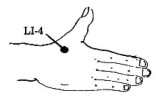 Using your thumb, rub the bottom of the right foot in a circular motion until the pain begins to subside.
Using your thumb, rub the bottom of the right foot in a circular motion until the pain begins to subside.
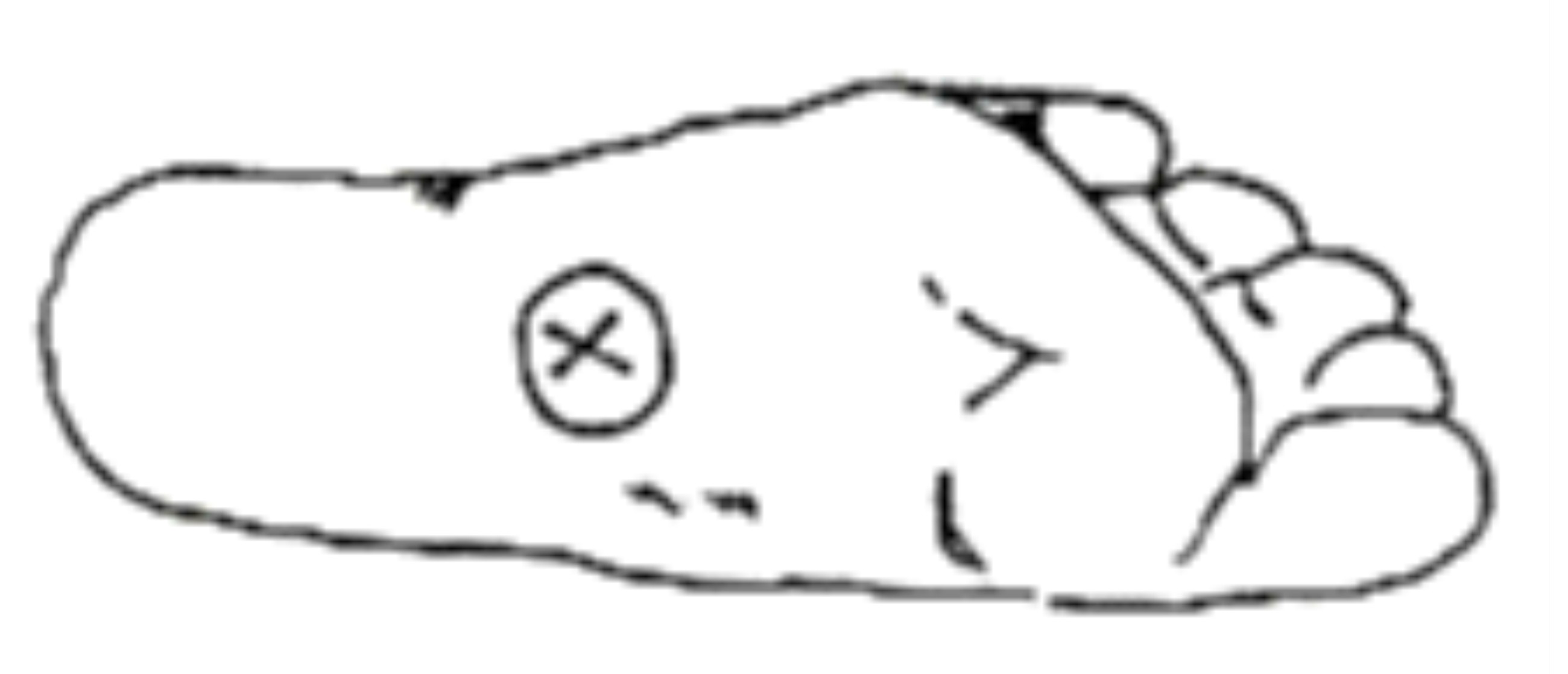 Cup your right hand so that the ends of your fingers are even and gently contact the bottom edge of the right rib cage. Hold just a slight pressure there for a minute or so to help relax the gallbladder. You may feel a gurgling or emptying of the gallbladder.
Cup your right hand so that the ends of your fingers are even and gently contact the bottom edge of the right rib cage. Hold just a slight pressure there for a minute or so to help relax the gallbladder. You may feel a gurgling or emptying of the gallbladder.
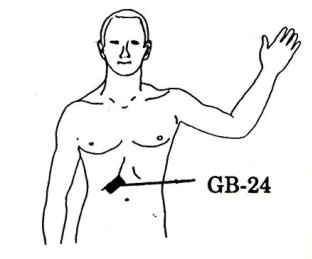 (Once you’ve performed the above three steps, then proceed with the next two.)
(Once you’ve performed the above three steps, then proceed with the next two.)
With your left thumb and index finger, again grasp the LI-4 point on the right hand. Place your other index finger over the Ampulla of Vater. Apply about 2 lbs. of pressure to each site and hold it for three or four minutes.
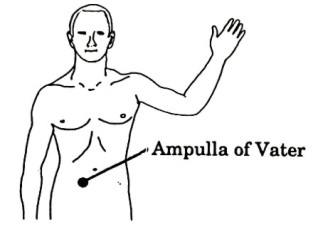 Next, apply direct, steady pressure of about 4 lbs. to the reflex point on the bottom of the right foot while at the same time applying 2 lbs. of pressure with your opposite hand to the Ampulla of Vater.
Next, apply direct, steady pressure of about 4 lbs. to the reflex point on the bottom of the right foot while at the same time applying 2 lbs. of pressure with your opposite hand to the Ampulla of Vater.
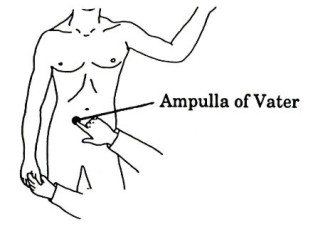 Priming your gallbladder for fats
Priming your gallbladder for fats
by Lori Lipinski, The Well Being Journal, May/June 2012
Is your gallbladder ready for fat? If you’re an American, chances are you’ve experienced problems with your gallbladder at one time or another. Typical gallbladder symptoms include: gas (especially burping after meals), a full or heavy feeling after meals, bloating, “acid reflux” (after meals and at night when lying down), pain in the right side radiating into the right shoulder blade, and loose or light colored stools that float.
Two things that the gallbladder doesn’t like are bad fats and no fats. Bad fats, like heat processed or hydrogenated vegetable oils, are difficult to digest and put a lot of stress on the gallbladder. The gallbladder is shaped like a little sack that sits alongside your liver. The liver produces bile, a substance made from cholesterol that emulsifies fat and makes it easier to digest. The gallbladder stores and concentrates bile, then secretes it into the small intestines when fats are present. If you don’t eat fat, the gallbladder won’t get any exercise and can begin to atrophy.
If you’ve eaten mostly bad fats in your life or have spent many years on a low-fat diet, chances are your gallbladder will need a little work before you will be able to completely digest generous amounts of good fats in your diet. Start by practicing good digestive habits, and enhance your digestion with raw apple cider vinegar. Mix 1 teaspoon with 2-4 ounces of water and drink with meals. A nice acid environment in the stomach stimulates the gallbladder to do its job. For additional support, I recommend Dr. Schulze’s formula to clean the liver and gallbladder. It’s called the L/GB-AP formula; call 800-HERBDOC to order.
Other helpful remedies include Swedish Bitters, 1 teaspoon in water taken just after meals, and lacto-fermented foods such as sauerkraut and beet kvass.
Coconut oil is very easy on the gallbladder because the preponderance of short- and medium-chain fatty acids it contains do not require bile salts for digestion. If you are just beginning to add fats to your diet after many years of low-fat foods, your best choice at the start is coconut oil.
How To Perform a Gallbladder Flush
by Dr. David Williams, drdavidwilliams.com, 11/8/2011
Clean out your gallbladder for optimal function
To ensure a free flow of bile, both into and out of the gallbladder, you should clean this organ out with a gallbladder flush. It’s simple to perform, but if you have a history of gallstones or other gallbladder issues, I suggest you check with your doctor first to rule out the possibility that you have any large calcified gallstones that might not be able to pass through the bile duct during the flush. And, obviously, you don’t need to perform the flush if you’ve had your gallbladder removed.
Boost the function of a bad gallbladder naturally
Improper gallbladder function makes it difficult to digest any fats in the diet, which can cause a wide variety of symptoms. Luckily, there are a few natural treatments
The gallbladder flush requires one week, beginning on a Monday and ending on a Sunday. Before you begin you’ll need to purchase:
- Plenty of apple juice or cider (not concentrate, but the real thing, without added sugars)
- Standard Process Disodium Phosphate Capsules (you can purchase these online)
- Citrus fruits for fresh-squeezed juice (you can substitute canned or bottled citrus fruit if you prefer) and to eat whole
- Unrefined olive oil, which is available at most health food stores
- Lemon juice
Then, starting on Monday morning, follow these instructions:
- Monday morning through noon on Saturday, drink as much apple juice or apple cider as your appetite will permit, in addition to your regular meals.
- At noon on Saturday, eat a normal lunch.
- Three hours later (at 3 p.m.), take 1 serving (3 capsules) of disodium phosphate with 8 ounces of water.
- Two hours later (at 5 p.m.), repeat step 3.
- Limit your evening meal to grapefruit or grapefruit juice, or other citrus fruits or juices.
- At bedtime, take either:
- ½ cup of unrefined olive oil followed by a small glass of grapefruit juice
- ½ cup of warm, unrefined olive oil blended with ½ cup of lemon juice.
- Go immediately to bed. For the first 30 minutes, lie on your right side with your right knee pulled up close to your chest.
- The next morning, one hour before breakfast, take 1 serving (3 capsules) of disodium phosphate with 8 ounces of water.
- Continue with your normal diet and activities.
What You Can Expect During the Gallbladder Flush
Some people feel slightly nauseated while they’re drinking the olive oil and citrus juice mixture. If you do, don’t fret. The feeling will disappear soon enough. You may also feel some discomfort in the area of your gallbladder—what’s known as the upper right quadrant, on the right side of your abdomen just below the rib cage. This is actually a good sign because it indicates your gallbladder is being stimulated. This feeling will also pass with time. On Sunday, you’ll likely feel the urge to defecate and may notice a change in the nature of your bowel movement. This is natural and is a result of the increased amount of bile released after the gallbladder flush. Some people report the presence of what look like dark green peas or even marbles in their stool. This is softened material from the gallbladder that has not yet become calcified. Again, it’s not cause for alarm, and indicates that the gallbladder cleansing has been effective.










